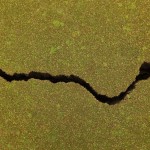Another Earthquake Makes for a Shaky Black Friday in North Texas
View North Texas Earthquakes in a larger map
A map of recent earthquakes (in red) and oil and gas wastewater disposal wells outside of Fort Worth. Active disposal wells are in green; inactive wells are in yellow. Map by Michael Marks/Terrence Henry
UPDATE: Another earthquake, magnitude 2.7, hit two miles north of Azle, Texas at approximately 9:44 Tuesday morning the 3rd of December according to the United States Geological Survey.
Another earthquake struck near the town of Azle just after midnight Friday, measuring 3.2 on the Richter scale. It was the 17th quake in the area around Eagle Mountain Lake (northwest of Fort Worth) in November, the largest a 3.6. No injuries have been reported from the quakes, but one local tells StateImpact Texas that the quakes are causing damage to homes and unnerving residents.
“It has damaged my house, my driveway is cracking down the driveway,” says Rebecca Williams of Azle. Cracks have also appeared on the outside of her home and in a retaining wall in her backyard. “When these [earthquakes] happen, my whole house shakes,” she says.
What’s behind the tremors? The area is not known for its seismic activity, but does have several wells used for disposing of wastewater from oil and gas drilling. Water used during the fracking process, as well as water that comes back up the well with oil and gas deposits, is typically disposed of by injecting it deep underground into wastewater wells. Those disposal wells, often located a mile or deeper underground, have been known to cause earthquakes in other parts of Dallas-Fort Worth, as well as other states like Oklahoma, Arkansas and Ohio. And they are the likely culprit here, says Ken Morgan, Director of the Energy Institute at Texas Christian University.
“If you pump fluids too much down a hole, you can begin to cause some instability,” Morgan says. “It’s usually minor, but that’s enough to [cause a quake]. I would suspect that we’ve got a little something going down. The depth of these [quakes], as best as we can find out, is about where disposal wells would be putting in some liquids.”
The injection of a massive amount of wastewater can cause existing faults to slip, triggering quakes in areas that up until now have been mostly earthquake-free.
The Railroad Commission of Texas, which oversees oil and gas drilling in the state and regulates disposal wells, says that they “welcome more data and science about current theories that hypothesize a causation link between minor seismic events and oil and gas activity.”
Several peer-reviewed studies of quakes in Texas have gone beyond the point of hypothesis, however, linking quakes in the area directly to specific disposal wells.The Railroad Commission does admit that some quakes are manmade, but says there are no “planned changes” to their policies. (In the map above, you can see where the quakes have occurred, as well as where disposal wells in the area are located.)
“I wouldn’t like it myself, under my home,” Morgan of TCU says of the quakes. “I would like them to stop.” Morgan says his group may look into the November quakes further.
Two other quakes struck over the weekend outside of Mineral Wells, some thirty miles west of Azle, the larger of them measuring 3.6. That area is also home to several disposal wells, and has seen its own series of smaller quakes in the past.
You can read more about the connection between disposal wells and earthquakes at our topic page.

